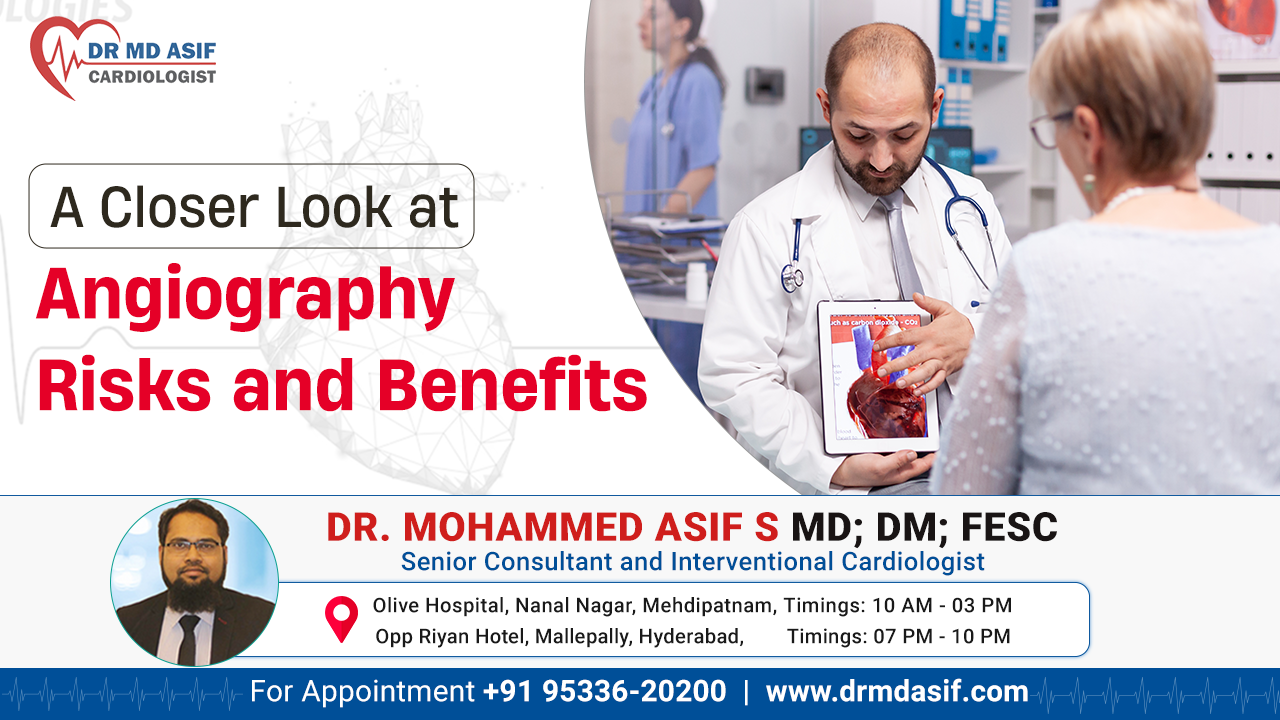Call us for any question
9533620200, 8179002888Meds Super Speciality Hospital
MallepallyTimings: 7 pm to 10 pm
mohammed4248asif@gmail.com

Blog s
A Closer Look at Angiography Risks and Benefits

Updated at: 05 Feb 2024
Introduction
Angiography is just like a window for blood vessels. It is a medical imaging technique that allows doctors to visualize inside your blood vessels. The best cardiologist in Hyderabad, uses this procedure to check multiple heart conditions. While an angiography can offer valuable insights, its essential to understand its risks and benefits associated with this procedure. The purpose of this blog is to explain in detail what an angiography is, its risks, and the benefits it offers to people who undergo it.
What is an angiography procedure?
Through the angiography procedure, the healthcare provider inject a contrast dye into the blood vessels. The dyes help to make visible those blood vessels on X-rays. Through this process the cardiologist will be able to see the condition of the blood vessels.
What are the types of angiography?
Majorly there are two types of angiography.
Conventional angiography:
It is called a traditional type of angiography. Through this process, the cardiologist injects the contrast dye through your arm or leg into the blood vessels. Then it flows in blood vessels, to make them visible on X-rays.
Computed Tomography Angiography:
It is the latest angiography technique, which gives detailed information about blood vessels. Many cardiologists use this procedure to diagnose different kinds of conditions. This process involves CT scans to get an image of your blood vessels.
Also read: The difference between angioplasty and angiogram
What are the risks & considerations involved with Angiography?
Angiography is a minimally invasive procedure. But some risks are also there. By following some simple considerations you can reduce the chances of its risk. These are:
Allergic Reaction:
Through the angiography process, some individuals may get allergic reactions due to that contrast dye. It can be mild to severe in different cases.
If you have any known allergies or previous reactions to contrast agents, then please share with your healthcare provider.
Infection and bleeding:
Catheter insertion is an invasive procedure, which carries a minimal risk of infection or bleeding. Healthcare providers take precautions to minimize these risks, but patients should be aware of potential complications.
Blood Vessel Injury:
In rare cases, angiography may cause damage to blood vessels. It happens due to insertion of catheters and guidewires. However, advancements in techniques and technologies have significantly reduced the likelihood of such complications.
Radiation Exposure:
Angiography process needs X-rays, which exposes patients to ionizing radiation. While the amount is generally considered safe, its important to balance the benefits of the procedure against potential radiation risks. You should be more careful for those individuals who may be more sensitive or require repeated imaging.
There is no more risk of angiography. But there may be some chances of any infection or allergic reaction for the people who have diabetes, or any kidney or heart related diseases. By taking certain precautions the risks can be reduced.
Such as:
To take antibiotics before starting the procedure.
Making blood pressure level under control.
Also read: An in-depth look at Coronary Angiogram
What are the benefits of angiography procedure?
At the best hospital in Hyderabad, an angiography procedure is used to see the inside blood vessels. It helps cardiologists to diagnose different conditions.
The benefits of using angiography are:
Helps cardiologists for accurate diagnosis:
One of the primary benefits of angiography is its ability to provide precise and detailed images of blood vessels. This aids healthcare professionals in diagnosing a range of conditions, including coronary artery disease, aneurysms, and peripheral arterial disease.
Guiding Treatment Decisions:
Angiography guides healthcare providers in making informed decisions about treatment. It allows for visualization of blockages, or abnormalities in blood vessels. All these things help doctors to prepare a proper plan for the treatment purpose. Such as angioplasty or stent placement.
Minimally Invasive
Angiography is a minimally invasive procedure. It often involves a catheter-based approach, reducing the need for open surgery. Also there is no risk of complications. It can result in quicker recovery times with shorter hospital stays.
Angiography gives real-time Imaging:
Angiography provides real-time imaging. It allows healthcare professionals to observe blood flow and make immediate assessments. This capability is especially crucial during interventional procedures, where timely decisions can impact outcomes.
Also read: Potential of Angioplasty
Conclusion:
Angiography is one of the best procedures which offer valuable insights into blood vessel health. While the benefits are substantial, its crucial for patients to be informed about the potential risks associated with the procedure. Open communication with the best heart specialist in Hyderabad ensures that individuals can make well-informed decisions, weighing the advantages of an angiography against any potential complications. Visit the best cardiology hospital in Hyderabad and consult with their cardiology team to discuss your specific situation and any concerns you may have.
Comments

Be the first to Comment
Latest Post
-
⇨10 ways to control high blood pressure without medication
-
⇨Know the Dos and Donts after heart bypass surgery
-
⇨Angioplasty vs CABG : All You Need to Know
-
⇨A Closer Look at Angiography Risks and Benefits
-
⇨What is the difference between angioplasty and angiogram?
-
⇨Connections Between Depression and Heart Disease: What You Need to Know
-
⇨Finding the Best Cardiologist in Hyderabad: Tips and Tricks
-
⇨How to Recognize the Signs of a Heart Attack or Heartburn
-
⇨Why Are Permanent Pacemakers Necessary, and what to expect during surgery?
-
⇨The Impact of Patent Ductus Arteriosus on Quality of Life| Dr Asif
-
⇨What Are the Causes, Risk Factors, and Treatments of Ventricular septal defect?
-
⇨Exploring the Pacemaker Surgery Cost in Hyderabad: What You Need to Know.
-
⇨Discovering the Different Types of ASD: What You Need to Know
-
⇨The TAVR Surgery Cost in Hyderabad: A Comprehensive Guide| Dr. Asif
-
⇨Exploring the Advantages of TAVR: What You Should Know
-
⇨Visualizing Heart Health: An In-Depth Look at Coronary Angiogram
-
⇨Unlocking the Potential of Angioplasty: Types, Procedure Steps, and Promoting Speedy Recovery
-
⇨How Cardiac Resynchronization Therapy Device Work: A Complete Guide
-
⇨AICD Implantation in Hyderabad: A Comprehensive Guide for Heart Patients
-
⇨Pacemaker Surgery and Its Types: A Comprehensive Overview




Leave a reply